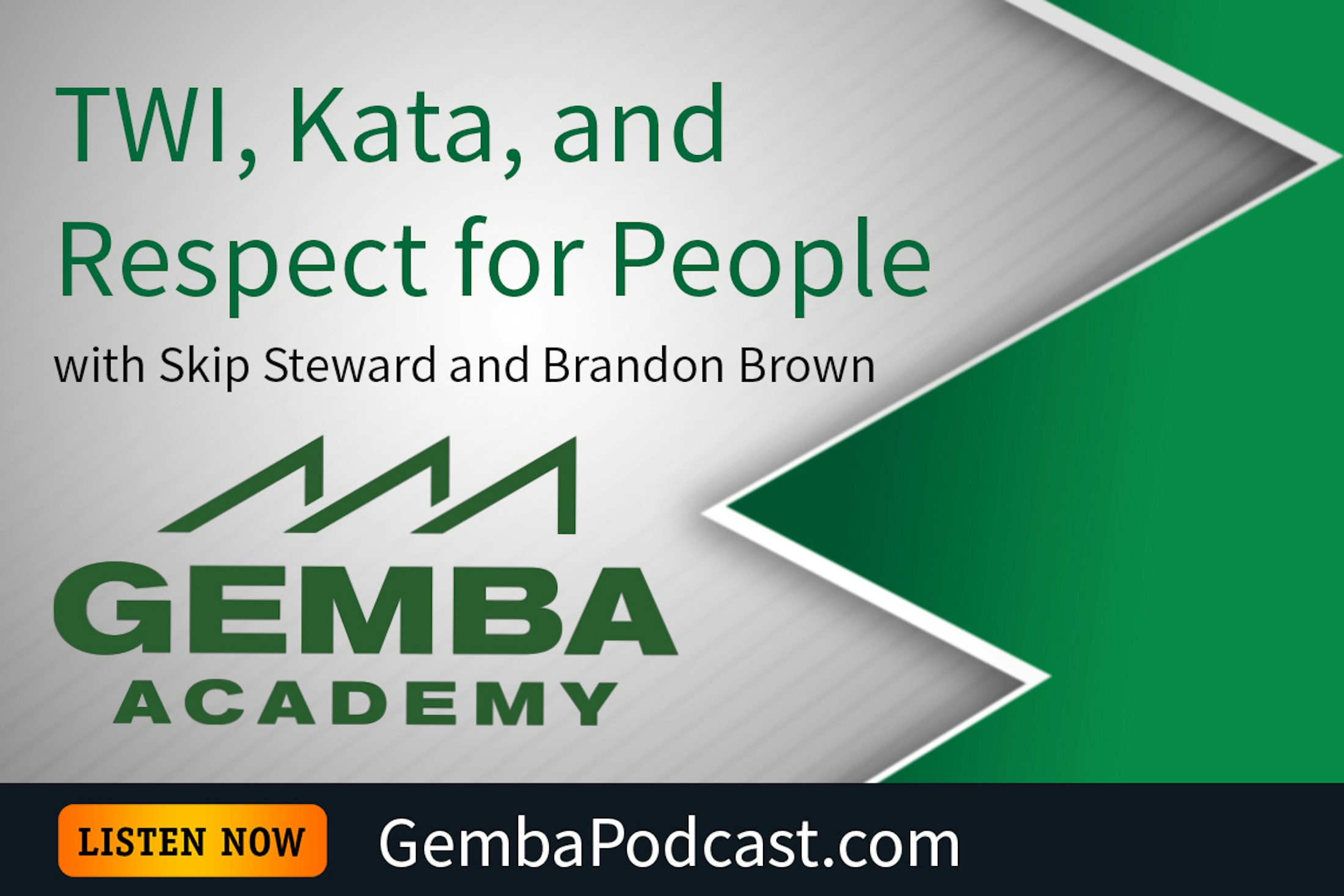Toyota Kata

From eliminating waste to streamlining operations, Lean’s entire philosophy is about developing people, driving continuous improvements and sustaining the results. Achieving sustainable gains requires building new habits and thinking patterns.
Toyota Kata is a methodology designed to take on the big challenge of creating a culture of continuous improvement by changing the way workers think and solve problems.
Let’s take a look at the core elements of Toyota Kata and how it can be used to drive meaningful change through regular practice.
What is Toyota Kata?
Toyota Kata is a systematic approach for developing continuous improvement habits that stick. The term “Toyota Kata” comes from Lean expert Mike Rother’s management book, Toyota Kata: Managing People for Improvement, Adaptiveness, and Superior Results. Rother spent six years observing Toyota’s continuous improvement process in action. His book builds on Toyota’s process, but adapts lessons learned from the production line into an improvement strategy you can apply to just about any process.
Toyota Kata Definition
Toyota Kata was adapted from the Japanese carmaker’s now-famed continuous improvement model. Kata is a Japanese word for “pattern, form, or routine.” Katas are structured exercises that aim to develop skills through ongoing practice.
Kata routines are often compared to activities like riding a bike, driving, or typing, which require a specific skill and mindset but can be done with little cognitive effort once you’ve mastered the basics.
The idea behind Toyota Kata is that by practicing improvement routines consistently, the process becomes second nature. Over time, you’ll develop a scientific approach to thinking critically, solving problems, and making quick decisions about what comes next.
What Is the 4 Step Improvement Kata Process?
- Understand the direction or challenge: In this first step we determine the problem we are trying to solve.
- Grasp the current condition: Once we define the challenge, we need to understand not only what we know to be true now, and also what we do not yet know. Put another way, we attempt to deeply understand the current condition.
- Establish the next target condition: Using an American football analogy, if the “challenge” is to score a touchdown…the target condition may very well be to get a first down. In other words, the target condition brings us one step closer to the challenge.
- Experiment against obstacles: Once a target condition is established, we then identify the obstacles in our way. These obstacles allow us to define, and run experiments against them in order to learn what works, and what doesn’t.
Our Toyota Kata resources will get you started with this invaluable tool in no time. You will learn about Toyota Kata, and have access to videos, podcasts, and more! Also, be sure to download the free coaching kata cards.
Coaching Kata & Improvement Kata
The Toyota Kata framework turns scientific thinking into a practical skill anyone, and any organization, can learn through the deliberate practice of a four-step learning and discovery process. By following the Toyota Kata structure, we will elegantly move from our current state to our desired future state. This structure is broken down into two practice routines.
- The Improvement Kata
- The Coaching Kata
An important note is that this is not a problem-solving methodology. Instead, it is meant to develop the habitual scientific thinking patterns necessary to effectively carry out problem-solving.
Improvement Kata
Improvement Kata helps individual learners develop a scientific approach to problem-solving. Learners work toward the desired outcome through a series of four steps:
- Understand the Direction or Challenge. Here, you’ll determine what problem you’re trying to solve or what you hope to achieve.
- Grasp the Current Condition. Next, you’ll take stock of the situation to determine where there are gaps in your knowledge. Ask yourself, “What do I not know?”
- Establish the Next Target Condition. Then, identify the next target condition. This represents the first major milestone and what needs to happen for you to get there: What obstacles are currently in the way? What will you need to learn?
- Experiment Against Obstacles. At this stage, you’ll run experiments against the obstacles you’ve identified. That doesn’t mean throwing random ideas at the problem and hoping something sticks. It’s about developing a hypothesis, testing it, and learning from your results.
Coaching Kata
Toyota Coaching Kata refers to a set of routines that aims to help managers develop coaching skills, as many lack experience coaching others. Coaching Kata also includes guiding learners through the Improvement Kata cycle. Essentially, Toyota Coaching Kata builds on the idea that learning and coaching go hand-in-hand, working together to facilitate collaboration.
How to Teach the Improvement Kata?
One thing athletes have in common with those learning the Improvement Kata is that both need a good coach.
More importantly, Kata Coaches need to have a consistent routine for teaching the Improvement Kata. This routine is clearly defined with the Coaching Kata.
The Kata coach uses five coaching questions during each coaching cycle. The learner responds to these questions by sharing what they have learned since the last coaching session. Coaching sessions usually last around 10 minutes and need to happen on a regular, often daily, basis.

What Are the 5 Coaching Kata Questions?
Coaches provide guidance, not solutions, and use a series of five questions to help learners successfully overcome obstacles and develop confidence.
The Five Toyota Kata Questions turn the four steps from the improvement process info questions that point toward a specific, achievable goal.
- What is the target condition?
- What is the actual condition right now?
- What obstacles are preventing you from achieving the target condition?
- What is Your Next Step? What Do You Expect to Happen?
- When can we see what was learned from taking that step?
There are also four questions you will ask to reflect on the last step taken:
- What did you plan as your last step?
- What were you expecting?
- What actually happened?
- What did you learn?
Toyota Kata Online Video Course
As part of our growing School of Lean library of courses, Toyota Kata - Practice Makes Progress, will guide you from the very beginning of Kata learning to being able to implement your own Kata experiments within a few days.
Through this course you will learn how to make lasting change, and importantly, where to start making your improvements.
Kata in the Classroom
The 4-step Improvement Kata makes for some great classroom exercises for participants of all ages! Watch our free Kata in the classroom videos to see how to run your own KiC events. Also make sure to download all of the materials from Mike Rother's Kata in the Classroom website.
How to Practice Toyota Kata in Your Own Organization
As you can see, Toyota Kata offers a structured approach for implementing a sustainable improvement culture.
Here are a few things to consider before getting started.
- Early on, familiarize learners with the Toyota Improvement Kata routine by applying the four steps and five Toyota Kata questions to a simple task.
- Initially, your strategy won’t include the Toyota Coaching Kata, as you won’t have any experienced coaches to guide the process. Instead, participants can take turns playing the “learner” and the “coach,” allowing them to develop both skills.
- Eventually, middle managers should fill this role as they interact directly with frontline workers every day.
- Develop a process for measuring program performance and skills development. You’ll want to track individual progress based on the length of PDCA cycles and their progress toward professional and company goals.
Gemba Academy’s Toyota Kata online training series will teach you how to implement this critical Lean strategy into your daily workflow, one small step at a time.
Watch the first installment in this module for free to get a feel for our approach to online learning.
Toyota Kata Podcasts
Our free Kata podcasts provide real world insights into practicing Kata.

How to Teach Kata in the Classroom
The tables are turned as Mike Rother interviews Ron Pereira about his experiences teaching Kata in the Classroom.
Listen Now
How to Change Your Culture with Toyota Kata
Emiel van Est discusses the vital role of culture in a continuous improvement journey, and how Kata can be used to sustain your success.
Listen Now
How to Think Scientifically in Healthcare
Maurene Stock and Katie Melching shed some light on their lean journey at Mercy Health Muskegon.
Listen Now
How to Think Scientifically
Stephen Derksen discusses how to start thinking scientifically using Toyota Kata.
Listen Now
How to Combine TWI, Kata, and a Kaizen Event
Brandon Brown talks about how his team have brought together multiple methods to create an effective learning system.
Listen Now
How to Understand Your Current Condition
Drew Locher discusses how to not rush to countermeasures before fully understanding your current condition.
Listen Now
Leveraging the Toyota Kata Approach to Learning & Coaching
Hear from Michael Lombard on how his hospital leverages Kata for learning and coaching.
Listen Now
How to Leverage Toyota Kata
Consultant Brandon Brown shares his knowledge of Toyota Kata with us, and explains how it compliments TWI.
Listen Now
How to Use Kata to Create Service Excellence
Author and lean practitioner Karyn Ross discusses Coaching Kata, and continuous improvement in a service context.
Listen Now
How to Apply Toyota Kata
Amy Mervak, Chief Quality and Compliance Officer at Hospice Care of Southwest Michigan, discusses how she and her team have been able to apply Kata.
Listen Now
TWI, Kata, and Respect for People
Skip Steward and Brandon Brown share their insights from the 2017 KataCon / TWI Summits.
Listen Now
How to Leverage the Improvement & Coaching Katas
Hear what makes Kata so valuable from Kata expert Mark Rosenthal.
Listen Now
How to Understand the Components of Kata
Kata expert Brandon Brown returns to the podcast to provide a comprehensive breakdown of both the improvement and coaching katas.
Listen NowListen to more great improvement podcasts at gembapodcast.com
Additional Video Content
- Toyota Kata Course - Practice Makes Perfect
- How Kata is Being Used to Deploy TWI at Baptist Memorial Healthcare
- Michael Lombard - 10 Lessons from Practicing Toyota Kata
- DSS Launches an Ambitious Project
- Will Lichtig - Using Kata to Address Wicked Problems in Safety
Blog Articles
New blog articles are published weekly. The following collection of articles are Toyota Kata focused.
- Kata in the Classroom
- Avoid the Ambush
- Has Anyone Seen My Target Condition?
- Learn, Grow, Share
- You Want Me to Do What!?!
- I Feel Better Already
- Lean Lessons From Driving on the Left Side of the Road
More Toyota Kata Resources
The following resources can help you on your Toyota Kata journey.
- Book: Toyota Kata: Managing People for Improvement, Adaptiveness and Superior Results by Mike Rother
- Book: Toyota Kata Practice Guide by Mike Rother
- Book: Toyota Kata Culture: Building Organizational Capability and Midset through Kata Coaching by Mike Rother and Gerd Aulinger
- Resource: Mike Rother's Toyota Kata Website
- Resource: Kata in the Classroom Website
- Resource: Toyota Kata YouTube Channel
- Consulting: Coaching & Facilitation Training
Offsite Toyota Kata Events
Gemba Academy can facilitate your own Toyota Kata offsite event at our training center in Keller, Texas.
Stay up to date on Kata
Make sure to sign up for our newsletter for all of our new video release notifications, lean news, podcasts and more!
Your message has been sent. We'll get back to you soon!
Sorry, there was an error with your submission:
